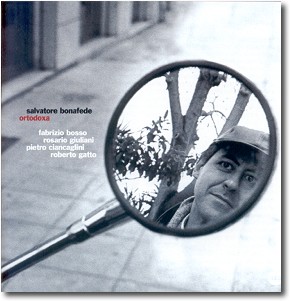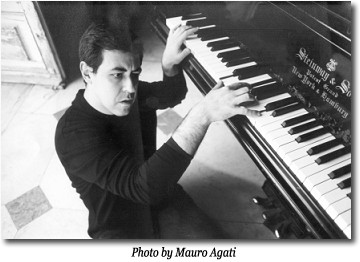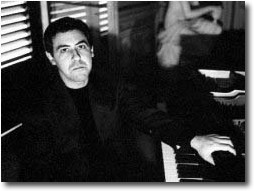|

|

Recorded In Rome, October 2000 |
Salvatore Bonafede
Ortodoxa
1. Little O In The Sky 7.28
2. Astor Piazzolla (Short Version) 2.48
3. Let's Waits And See 8.57
4. Charles Mingus 8.30

5. Il Matrimonio 5.35
6. Enrico Rava 4.17
7. If I Were A Ball 3.52
8. Pasion 3.12
9. I Like This Place 6.19
10. Federico Fellini 2.00

11. Astor Piazzolla 8.51
Salvatore Bonafede:
Piano
Fabrizio Bosso: Trumpet
Flughelhorn
Rosario Giuliani: Sax
Alto,
Soprano
Pietro Ciancaglini:
Bass
Roberto Gatto:
Drums
All Music By
Salvatore Bonafede
Foto: Pino Ninfa |

 Liner
Notes Liner
Notes
Salvatore Bonafede's
compositions create a sound and a sense of the melody which is very much
Italian, reminding in particular of southern Italy, inserted into the great
tradition of modern jazz. Charlie Haden, Charles Mingus, Horace Silver,
echoes of the Latin and afro Latin world, Nino Rota, Astor Piazzolla,
Venezuelan Joropo, Enrico Rava. A drums and bass suite in which two
pieces, linked together yet very different one from the other, have the drums
and the double bass as soloists to which the rest of the band provides an
effective and boldly simple melodic background. A miniature dedicated to
Federico Fellini in which the evocation of an Italy lost in our memories becomes
more marked. A fresh, original, surprisingly evocative music, surely destined to
remain, in which the quality of writing is always subdued by a urgency of
expressiveness capable of giving us back a "landscape of the soul"; echoes of a
world belonging to the afro Latin side, which is as topical as ever today, whose
melodic nature and colour of the various themes contain the flavours of peasant
bands. Yet these themes are transformed in compositions of unmistakable jazz
flavour and structure.
The contributions of the single musicians to the complete success of this
work are considerable both for their ability in interpreting and enriching
Salvatore Bonafede's
compositions and for the authority with which they have done this difficult
task. To all of them goes a particular thanks, starting with Roberto Gatto,
an esteemed and trustable drummer as nobody else is, who was especially wanted
by Salvatore. Piero Ciancaglini can be appreciated for his sense of time,
touch and pitching; together with Salvatore e Roberto, he has formed a rhythmic
team of great efficacy and solidity, both as a pivot and a pulsing heart of the
music and in the soloist space allotted to them. Rosario Giuliani took up
his job with competence, professionalism and measure, adding a bit of that fire
which is so typical of him. Fabrizio
Bosso was the soloist who could give Bonafede’s compositions that
particular sound and colour, a mix of brilliancy and melancholy which, as I see
it, give this music something special which can be so easily spotted as it is
indefinable in the presentation of tempos and in the climax of the solos.
 Maybe
it's the case to reconsider the truth in Bobby Watson's saying that in a
period of internationalisation and globalisation or 'glocal' as they say
recently the epoch in which the word 'jazz' meant just America comes to an end,
even though it remains the unavoidable place of reference to get the knowledge
of the languages and dialects of jazz. I would like to add something at this
sentence: more and more often, as in the case of this work and of other
recording from the Red Record catalogue, it’s from the periphery that come the
most expressive and representative works of today’s jazz scene. The peripheric
position allows for a different perspective and distance in the point of view,
as Max Corroto noted in reviewing the CD by the Argentinean jazz
guitarist Pablo
Bobrowicky. Such a kind of works is an expression of true musicians,
capable and prepared, who have something to say; musicians just like those
Bonafede gathered together for his music. Maybe
it's the case to reconsider the truth in Bobby Watson's saying that in a
period of internationalisation and globalisation or 'glocal' as they say
recently the epoch in which the word 'jazz' meant just America comes to an end,
even though it remains the unavoidable place of reference to get the knowledge
of the languages and dialects of jazz. I would like to add something at this
sentence: more and more often, as in the case of this work and of other
recording from the Red Record catalogue, it’s from the periphery that come the
most expressive and representative works of today’s jazz scene. The peripheric
position allows for a different perspective and distance in the point of view,
as Max Corroto noted in reviewing the CD by the Argentinean jazz
guitarist Pablo
Bobrowicky. Such a kind of works is an expression of true musicians,
capable and prepared, who have something to say; musicians just like those
Bonafede gathered together for his music.
Daniele Cecchini
Listening Guide
Little O In The Sky
(1999). Jazz space.
Probably, in a near or remote future, some jazz recordings will be brought to
the moon (which is ¼ of the Earth) and I’m sure they are going to be mainstream.
If Ortodoxa will have a chance it will be thanks to this piece.
Astor Piazzolla
(1992). Ecce poeta (Here is
the poet). This piece is in five parts: 1. on a repeated harmonic base all the
instruments intertwine, reflecting themselves in the dramatisation (minor
tonality) of a music born in the street, just like jazz; 2. the melodic singing,
the lyrical character hidden up to this moment, is let loose; 3. we return to
the original sound magma, with hints of improvisation; 4. and 5. the second tune
appears again, apparently more playful, and then is reabsorbed in the solemn
serenity of the reprise with a coda.
Let's Wait And See
(1999) is Ortodoxa’s mysterious and longing piece. It’s dedicated to those
things that friends, colleagues, parents or anybody else define ‘promises’.
Autobiographical? We’ll see.
Charles Mingus
(1999) or composition,
decomposition, recomposition. Rhythmic variations (ballad, rumba, swing) run one
after the other to evoke some of the multiple aspects of his personality.
Il Matrimonio (The
Marriage) (2000) is the
most recent composition in this recording and that of the most dancing nature,
based on the rhythm of a folk dance from Venezuela called joropo. It just
recalls the joyful setting of a marriage.
Enrico Rava
(1992) is a tune with a suspended atmosphere, in which European tradition stays
at the side of a harmonic treatment (mostly based on one of Enrico’s pieces)
which gives space to different sensations.
The title If I Were A
Ball
(1993) is not a variation
on Frank Loesser’s piece If I Were a Bell (I also composed If I Were a Bull…);
it’s a 24 measure blues with a thematic development of the minimum number of
notes (two). While Pietro, Fabrizio, Rosario and I try to make the piece roll,
Roberto tries to make it bounce.
Pasion
(2000) reminds the
atmospheres created by Charlie Haden in many of his works. The principal
soloist, then, is Piero, while the theme is just a pretext.
I Like This Place
(1993). Over a bass line
repeated at a constant pace, the theme follows his own tempo, before joining the
rhythm. Subordinate independence. I like this condition!
Federico Fellini
(1993). Melancholy of
farewell. Everything has a sense. And an end.
Salvatore Bonafede
Insert an opinion
Questa pagina è stata visitata 3.789 volte
Data ultima modifica: 31/01/2005

|
|

